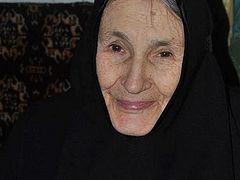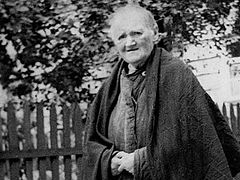 Schema-Abbess Magdalena (Dosmanova)
Schema-Abbess Magdalena (Dosmanova)
It was at midnight. When in the Soviet city of Sverdlovsk (formerly Ekaterinburg) all the streets had become deserted, the sound of voices died away, and light in the windows of houses went out, in a house at Tretya Zagorodnaya Street Mother Magdalena and her eighteen disciples gathered in a big room and lit a candle. One of the sisters took a book, the others took prayer ropes. The sister was reading in a low yet sonorous voice: “To Thee the Champion Leader, the Sovereign Lady Mother of God, we sing our thanks for the appearance of Her wondrous icon…” While the Soviet city was sleeping, the mother superior and her sisters were praying.
This is how the small community of nuns of the former Novo-Tikhvin Convent and their spiritual mother would spend every night. God was with them, and the Theotokos listened to their prayers… And new sisters kept coming to Mother Magdalena despite the fact that the convent had been closed for a long time. It was because she set them on the path leading to God and the Heavenly Kingdom. July 29, 2019, marked the eighty-fifth anniversary since the repose of Schema-Abbess Magdalena (Dosmanova).
A nun from childhood
 Mother Magdalena in her youth In pre-revolutionary Russia it was considered a special blessing of God when a child from a pious family decided to take up monasticism. This was also the case with the family of Pelagea Dosmanova, the future Mother Magdalena. When Pelagea was about twelve, her father, seeing his daughter’s love for prayer and the Lives of saints, asked her: “My little daughter, will you join a convent?” The girl replied eagerly: “Yes, I will!” And her father Stephen took her to Novo-Tikhvin Convent.
Mother Magdalena in her youth In pre-revolutionary Russia it was considered a special blessing of God when a child from a pious family decided to take up monasticism. This was also the case with the family of Pelagea Dosmanova, the future Mother Magdalena. When Pelagea was about twelve, her father, seeing his daughter’s love for prayer and the Lives of saints, asked her: “My little daughter, will you join a convent?” The girl replied eagerly: “Yes, I will!” And her father Stephen took her to Novo-Tikhvin Convent.
First the young novice helped at the convent’s candle factory and then in the abbess’s quarters. As years went by, she was assigned ever more difficult and important obediences, and Sister Pelagia carried out any kind of work zealously. All the nuns loved her, feeling her special spiritual power, coupled with her mildness and affection towards every single human being.
In 1893, Pelagea was tonsured and became Nun Magdalena, and two years later the sisters unanimously elected her as their abbess “by virtue of her pious life and meek, gentle spirit”, as the election act read.
“I admit those who cannot live without God”
On becoming abbess Mother Magdalena labored tirelessly, decorating churches, making the sisters’ cells comfortable, seeing to it that the convent was kept in perfect order as she wanted it to resemble Paradise. But above all she wished her sisters to have Paradise in their hearts.
The mother-superior taught them to pray, encouraged them to read the books by which many generations of monastics were trained from time immemorial: the Philokalia, the Ladder of Divine Ascent, Instructions of Abba Dorotheos of Gaza, St. Ephraim the Syrian, and Isaac the Syrian, homilies by the Holy Hierarchs Basil the Great, Ambrose of Milan, Dimitry of Rostov, and others. Like the abbots of the olden times, such as St. Theodosius of the Kiev Caves and St. Sergius of Radonezh, Mother Magdalena would often go the round of the nuns’ cells to make sure they were doing well and that they hadn’t abandoned their prayer and reading.
 The abbess’s main concern was to ensure that the spirit of love and reverence towards one’s neighbors reigned in the convent. The following episode demonstrates this. The parents of one novice came to the convent and the nuns showed them around the convent as was their custom. When they entered the icon-painting workshop, all the sisters, much to the parents’ amazement, suddenly rose as one and made a low bow as a token of their deep reverence. The parents were moved to tears, and that episode was imprinted on their memory forever.
The abbess’s main concern was to ensure that the spirit of love and reverence towards one’s neighbors reigned in the convent. The following episode demonstrates this. The parents of one novice came to the convent and the nuns showed them around the convent as was their custom. When they entered the icon-painting workshop, all the sisters, much to the parents’ amazement, suddenly rose as one and made a low bow as a token of their deep reverence. The parents were moved to tears, and that episode was imprinted on their memory forever.
Many young women came to the convent, wishing to pursue the monastic life under the guidance of the wise abbess Magdalena. The number of the nuns increased and eventually reached about 1000, like in ancient lavras. One day the abbess’s distant relative came too. She complained that she couldn’t get along with her family and asked Mother Magdalena to admit her. The mother superior tried her best to console her relative, but replied to her lovingly and wisely, “I admit those who cannot live without God to my convent, and not those who cannot live with people.”
I was sick, and ye visited Me: I was in prison, and ye came unto Me (Mt. 25:36)
When Russia entered its troubled times, Mother Magdalena tried to alleviate the sorrows of her neighbors to obey the commandment of God. During the First World War the convent donated its money and valuables for the needs of the men at the front; an infirmary for wounded soldiers was opened in the convent as well.
In 1918, many people who were out of favor with the Soviet authorities were exiled to Ekaterinburg; among them were members of the Royal Family, hierarchs and clergy. Mother Magdalena’s heart ached for all who were unjustly imprisoned. She blessed her nuns to deliver food to Ipatiev House where St. Nicholas II and his family were kept captive. They would bring them milk for Tsarevich Alexei, cream, eggs, butter, bread, bread rolls and cakes, vegetables, and meat. The sisters did this every day right up to that fateful day when the Royal Martyrs were executed by firing squad.
When Grand Duchess Elizabeth Feodorovna was exiled to Ekaterinburg, the sisters filed a petition to the Bolsheviks, pleading with them to allow her to live in their convent, but the petition was denied. They also supported Bishop Germogen (Dolganev) of Tobolsk, who was incarcerated in a local “arrest house” [such buildings were constructed in the Russian Empire: those who were sentenced by the city’s or town’s justice of the peace were kept there.—Trans.]: the convent would deliver dinners to him, and the abbess would visit him. One day, at Mother Magdalena’s earnest request, the bishop was allowed to celebrate the Liturgy in jail, and many of the inmates were able to take Communion.
By helping the Imperial Martyrs and other captives openly, Mother Magdalena and her nuns truly performed the podvig of confessors. After all, at that time people were afraid to display sympathy for political prisoners, to say nothing of helping them, since they knew that their own freedom and lives would be put at risk.
The “convent” at Tretya Zagorodnaya Street
 Holy Grand Duchess Elizabeth Novo-Tikhvin Convent shared the fate of most Russian churches, monasteries, and convents. In 1920, the convent was closed and all the sisters evicted. The Bolsheviks hung a large poster above the convent gate, which read: “Long live the world Communist Revolution!” When the abbess and her disciples came to pray by the walls of their beloved convent from time to time, they looked at that slogan with aching hearts. Now the convent they had beautified for many years presented a sorry spectacle, ruined and desecrated by the Communist banner.
Holy Grand Duchess Elizabeth Novo-Tikhvin Convent shared the fate of most Russian churches, monasteries, and convents. In 1920, the convent was closed and all the sisters evicted. The Bolsheviks hung a large poster above the convent gate, which read: “Long live the world Communist Revolution!” When the abbess and her disciples came to pray by the walls of their beloved convent from time to time, they looked at that slogan with aching hearts. Now the convent they had beautified for many years presented a sorry spectacle, ruined and desecrated by the Communist banner.
Mother Magdalena took up her residence near the convent, in a private house at Tretya Zagorodnaya Street (now Schmidt Street). Eighteen sisters lived with her, and the others would often visit her for prayer, counsel, and spiritual instructions. Thus a monastic community was formed and it continued to live by the rules of the holy fathers of the Church. In that period of sorrows the virtues and spiritual experience of Abbess Magdalena that she had acquired over many years were revealed in full measure. She didn’t lose heart after she had been banished from the convent, which no longer existed. As ever, her main and only concern was prayer and attaining perfection in Christian virtues. The mother-superior was the same both amid the numerous cares (when she governed a huge convent) and amid the privation and persecution under the Soviet Government.
 The seizure of church valuables
The seizure of church valuables
 Abbess Magdalena The sisters lived in the house at Tretya Zagorodnaya Street just as they had lived in the convent before then: At night they would rise to perform the monastic rule and read the Akathist hymn to the Tikhvin icon of the Mother of God; during the day they would work, read the patristic writings and sometimes attend services in churches; they would ask for their abbess’s blessing before doing anything. As an eldress and spiritual instructor she combined leniency based on prudence with moderate strictness. She directed her disciples’ spiritual energies toward seeking purity of heart, and taught them to maintain love for and peace with their neighbors, saying: “Bodily podvigs are beyond our capability, but we can only fulfil the law by bearing each other’s burdens.” However, while she was lenient towards their physical weakness, Mother Magdalena kept her eye on her disciples’ spiritual health—she forbade them to indulge in idle talk and laughter without a reason. She exhorted them not to ask unnecessary questions anywhere, saying that curiosity is the source of all vices. Mother Magdalena instructed them to start and end each day with the Jesus Prayer and spend all of their spare time in prayer. She never parted with her prayer rope and prayed much.
Abbess Magdalena The sisters lived in the house at Tretya Zagorodnaya Street just as they had lived in the convent before then: At night they would rise to perform the monastic rule and read the Akathist hymn to the Tikhvin icon of the Mother of God; during the day they would work, read the patristic writings and sometimes attend services in churches; they would ask for their abbess’s blessing before doing anything. As an eldress and spiritual instructor she combined leniency based on prudence with moderate strictness. She directed her disciples’ spiritual energies toward seeking purity of heart, and taught them to maintain love for and peace with their neighbors, saying: “Bodily podvigs are beyond our capability, but we can only fulfil the law by bearing each other’s burdens.” However, while she was lenient towards their physical weakness, Mother Magdalena kept her eye on her disciples’ spiritual health—she forbade them to indulge in idle talk and laughter without a reason. She exhorted them not to ask unnecessary questions anywhere, saying that curiosity is the source of all vices. Mother Magdalena instructed them to start and end each day with the Jesus Prayer and spend all of their spare time in prayer. She never parted with her prayer rope and prayed much.
A grace-filled eldress
 Galina Zasypkina The convent had been closed for a long time, but new sisters kept flocking to Mother Magdalena to dedicate their energies to God. In 1930, Galina Zasypkina, the future Schema-Nun Nikolaya, came to the community. It is from her accounts that we know details of the final years of Mother Magdalena’s life and her service as an eldress.
Galina Zasypkina The convent had been closed for a long time, but new sisters kept flocking to Mother Magdalena to dedicate their energies to God. In 1930, Galina Zasypkina, the future Schema-Nun Nikolaya, came to the community. It is from her accounts that we know details of the final years of Mother Magdalena’s life and her service as an eldress.
Initially, Galina’s mother was opposed to her daughter’s choice (who wanted to become a nun) saying that it was impossible to lead the monastic life anymore, because there were persecutions and there were no instructors… But Galina replied to her mother: “One instructor—the mother superior—will be sufficient for us.” Mother Magdalena said concerning this discord that Galina’s mother would put up with her daughter’s choice, that she would even be happy with it and eventually become a nun too. And her prediction came true.
Galina Zasypkina trusted Mother Magdalena completely. She gladly performed whatever the abbess blessed her to do—she went to work in a headscarf, hiding her luxuriant, beautiful hair, and never took her cross (that she wore around her neck) off. Once during Holy Week Mother Magdalena offered an egg to whoever entered her cell. All the girls except Galina declined and laughed, but Galina took the egg without a moment’s thought and ate it. In the evening Abbess Magdalena said about Galina: “I have only one sister who is truly obedient to me.”
The eldress blessed her spiritual daughters to deliver parcels to clergy and monastics who were languishing in prisons. Galina Zasypkina carried out this assignment fearlessly. Investigators asked her during an interrogation:
“Will you go to church?”
“I will.”
“Will you give parcels to your acquaintances in jail?”
“Yes, I will. And if you end up in jail, I will bring them to you too.”
 Nun Nikolaya Despite her “impertinent” answers, Galina was never arrested, as Abbess Magdalena had predicted. Afterwards Galina would often recall the eldress’s prophetic words: “I would serve ten years in prison, if only you wouldn’t be arrested! But you won’t be arrested anyway. Don’t renounce your faith, and don’t fear.”
Nun Nikolaya Despite her “impertinent” answers, Galina was never arrested, as Abbess Magdalena had predicted. Afterwards Galina would often recall the eldress’s prophetic words: “I would serve ten years in prison, if only you wouldn’t be arrested! But you won’t be arrested anyway. Don’t renounce your faith, and don’t fear.”
According to Galina’s reminiscences, Mother Magdalena was arrested on several occasions. The eldress “played the fool” during interrogations, which helped her avoid exile or long-term imprisonment. Whatever investigators asked her, she would repeat time and again: “Yes, we had headscarves and rags at the convent; we would stack them up, sort them out and iron them out.” Saying this, she would smooth out a headscarf on her knees. The abbess was kept in detention for two to three months every time. Once she was subjected to a sophisticated form of torture: she was put into a “street-car”—a cell chock-full of people where everybody only could stand and not sit. The prisoners, feeling sympathy for the aged woman, managed to slightly move apart somehow to give space for her to sit down on the floor. Mother Magdalena got cold feet on the cold cement and suffered from that illness for the rest of her life.
The eldress predicted the exact time of her death. When she fell seriously ill, she consoled one of her disciples who had burst into tears by the promise to live for another year. And she was right: she had exactly one year to live.
Three days before her repose, Mother Magdalena sent for Archbishop Makary/Macarius (Zvezdov). The archbishop came on the same day and tonsured her into the great schema. Over the three remaining days of her life she took Communion daily. Upon learning that the eldress was on her deathbed, many believers came to bid her farewell. She blessed almost all of them with the icon of the Mother of God “the Deliveress”. However, she blessed Galina Zasypkina (to the latter’s astonishment) with an icon of St. Nicholas the Wonderworker. Galina remembered this blessing later, when she was tonsured a nun and heard her new name, Nikolaya, for the first time.
On July 29, 1934, Schema-Abbess Magdalena peacefully fell asleep in the Lord, surrounded by her spiritual daughters. Just before her repose the abbess blessed everybody with the Tikhvin icon of the Theotokos and said: “I entrust you to the care of the Queen of Heaven…”
Schema-Abbess Magdalena was buried at Ivanovskoye Cemetery. Multitudes of people came to her funeral, with people carrying her coffin through the city in their arms. A wooden cross was erected on her grave, and her spiritual daughters wrote on the memorial plaque with reverence and love: “Dear mother, pray to God for us!”






